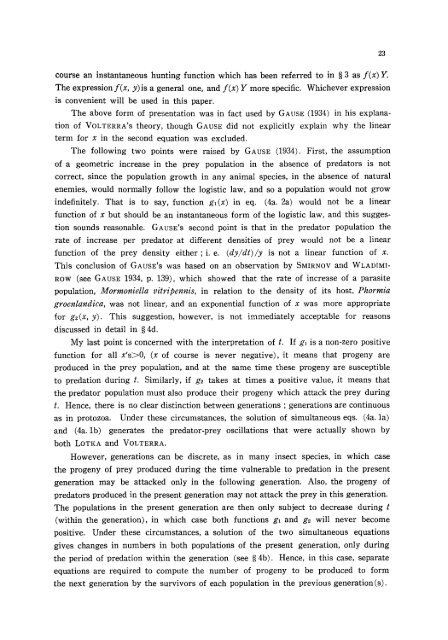A comparative study of models for predation and parasitism
A comparative study of models for predation and parasitism
A comparative study of models for predation and parasitism
Create successful ePaper yourself
Turn your PDF publications into a flip-book with our unique Google optimized e-Paper software.
course an instantaneous hunting function which has been referred to in w 3 as f(x) Y.<br />
The expression f(x, y) is a general one, <strong>and</strong> f(x) Y more specific. Whichever expression<br />
is convenient will be used in this paper.<br />
The above <strong>for</strong>m <strong>of</strong> presentation was in fact used by GAUSE (1934) in his explana-<br />
tion <strong>of</strong> VOLTERRA'S theory, though GAUSE did not explicitly explain why the linear<br />
term <strong>for</strong> x in the second equation was excluded.<br />
The following two points were raised by GAUSE (1934). First, the assumption<br />
<strong>of</strong> a geometric increase in the prey population in the absence <strong>of</strong> predators is not<br />
correct, since the population growth in any animal species, in the absence <strong>of</strong> natural<br />
enemies, would normally follow the logistic law, <strong>and</strong> so a population would not grow<br />
indefinitely. That is to say, function g~(x) in eq.<br />
23<br />
(4a. 2a) would not be a linear<br />
function <strong>of</strong> x but should be an instantaneous <strong>for</strong>m <strong>of</strong> the logistic law, <strong>and</strong> this sugges-<br />
tion sounds reasonable. GAUSE'S second point is that in the predator population the<br />
rate <strong>of</strong> increase per predator at different densities <strong>of</strong> prey would not be a linear<br />
function <strong>of</strong> the prey density either ; i.e. (dy/dt)/y is not a linear function <strong>of</strong> x.<br />
This conclusion <strong>of</strong> GAUSE'S was based on an observation by SMIRNOV <strong>and</strong> WLADIMI-<br />
gOW (see GAUSE 1934, p. 139), which showed that the rate <strong>of</strong> increase <strong>of</strong> a parasite<br />
population, Morrnoniella vitripennis, in relation to the density <strong>of</strong> its host, Phorrnia<br />
groenlaudica, was not linear, <strong>and</strong> an exponential function <strong>of</strong> x was more appropriate<br />
<strong>for</strong> gs(x, y). This suggestion, however, is not immediately acceptable <strong>for</strong> reasons<br />
discussed in detail in w 4d.<br />
My last point is concerned with the interpretation <strong>of</strong> t. If g~ is a non-zero positive<br />
function <strong>for</strong> all x's~0, (x <strong>of</strong> course is never negative), it means that progeny are<br />
produced in the prey population, <strong>and</strong> at the same time these progeny are susceptible<br />
to <strong>predation</strong> during t. Similarly, if g2 takes at times a positive value, it means that<br />
the predator population must also produce their progeny which attack the prey during<br />
t. Hence, there is no clear distinction between generations ; generations are continuous<br />
as in protozoa.<br />
<strong>and</strong> (4a. lb)<br />
Under these circumstances, the solution <strong>of</strong> simultaneous eqs. (4a. la)<br />
generates the predator-prey oscillations that were actually shown by<br />
both LOTKA <strong>and</strong> VOLTERRA.<br />
However, generations can be discrete, as in many insect species, in which case<br />
the progeny <strong>of</strong> prey produced during the time vulnerable to <strong>predation</strong> in the present<br />
generation may be attacked only in the following generation. Also, the progeny <strong>of</strong><br />
predators produced in the present generation may not attack the prey in this generation.<br />
The populations in the present generation are then only subject to decrease during t<br />
(within the generation), in which case both functions g~ <strong>and</strong> g2 will never become<br />
positive. Under these circumstances, a solution <strong>of</strong> the two simultaneous equations<br />
gives changes in numbers in both populations <strong>of</strong> the present generation, only during<br />
the period <strong>of</strong> <strong>predation</strong> within the generation (see w 4b). Hence, in this case, separate<br />
equations are required to compute the number <strong>of</strong> progeny to be produced to <strong>for</strong>m<br />
the next generation by the survivors <strong>of</strong> each population in the previous generation (s).















